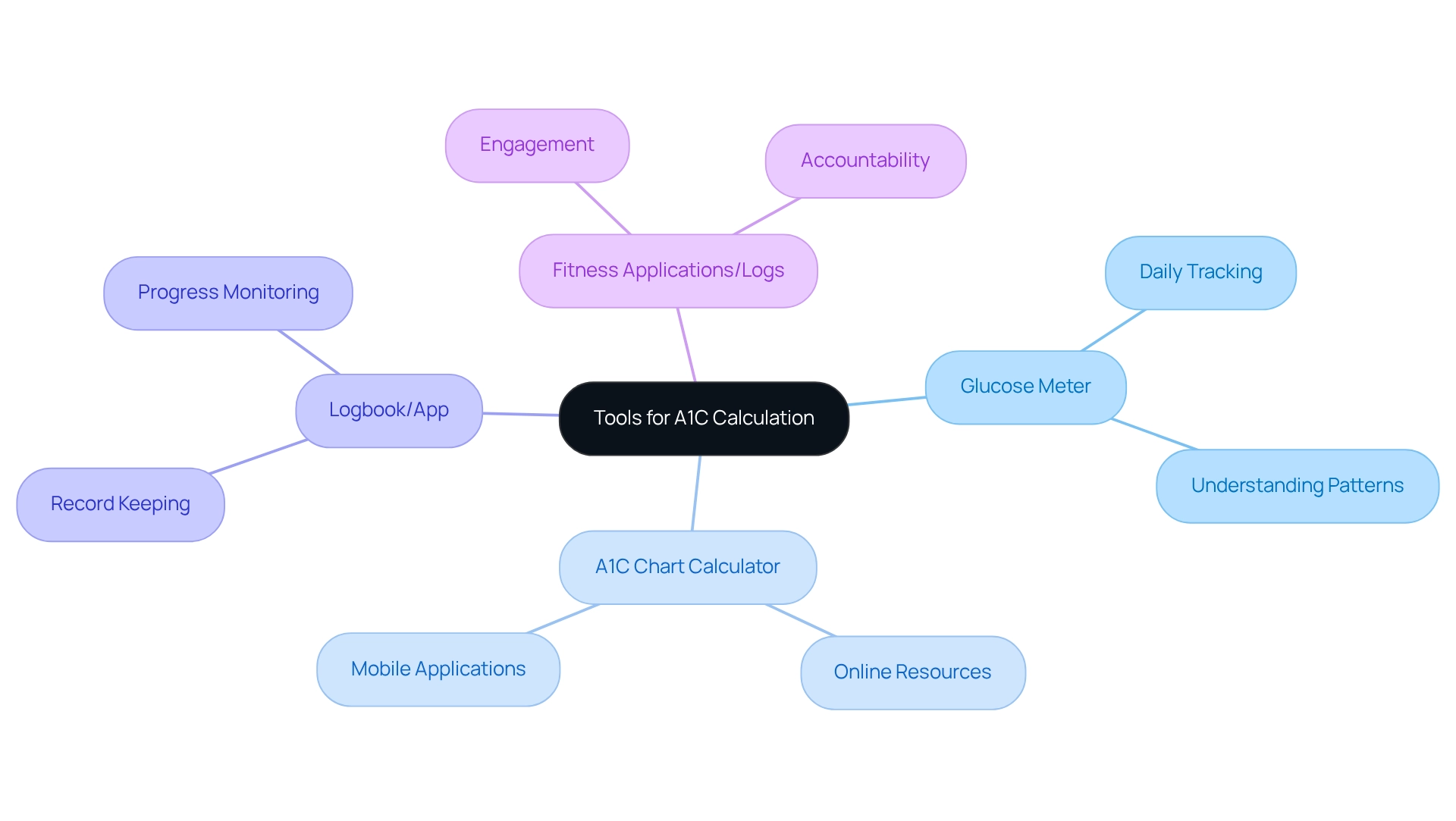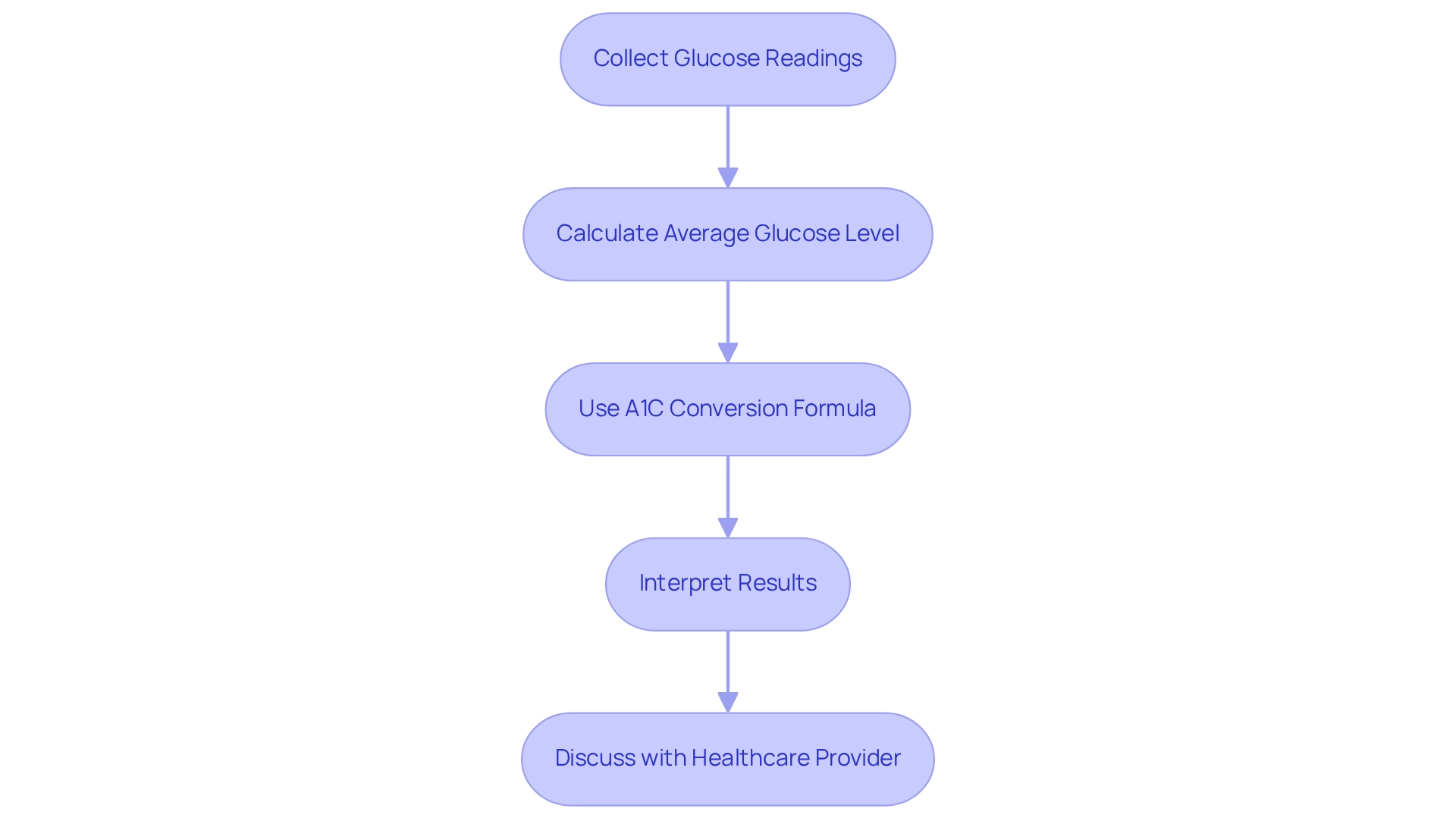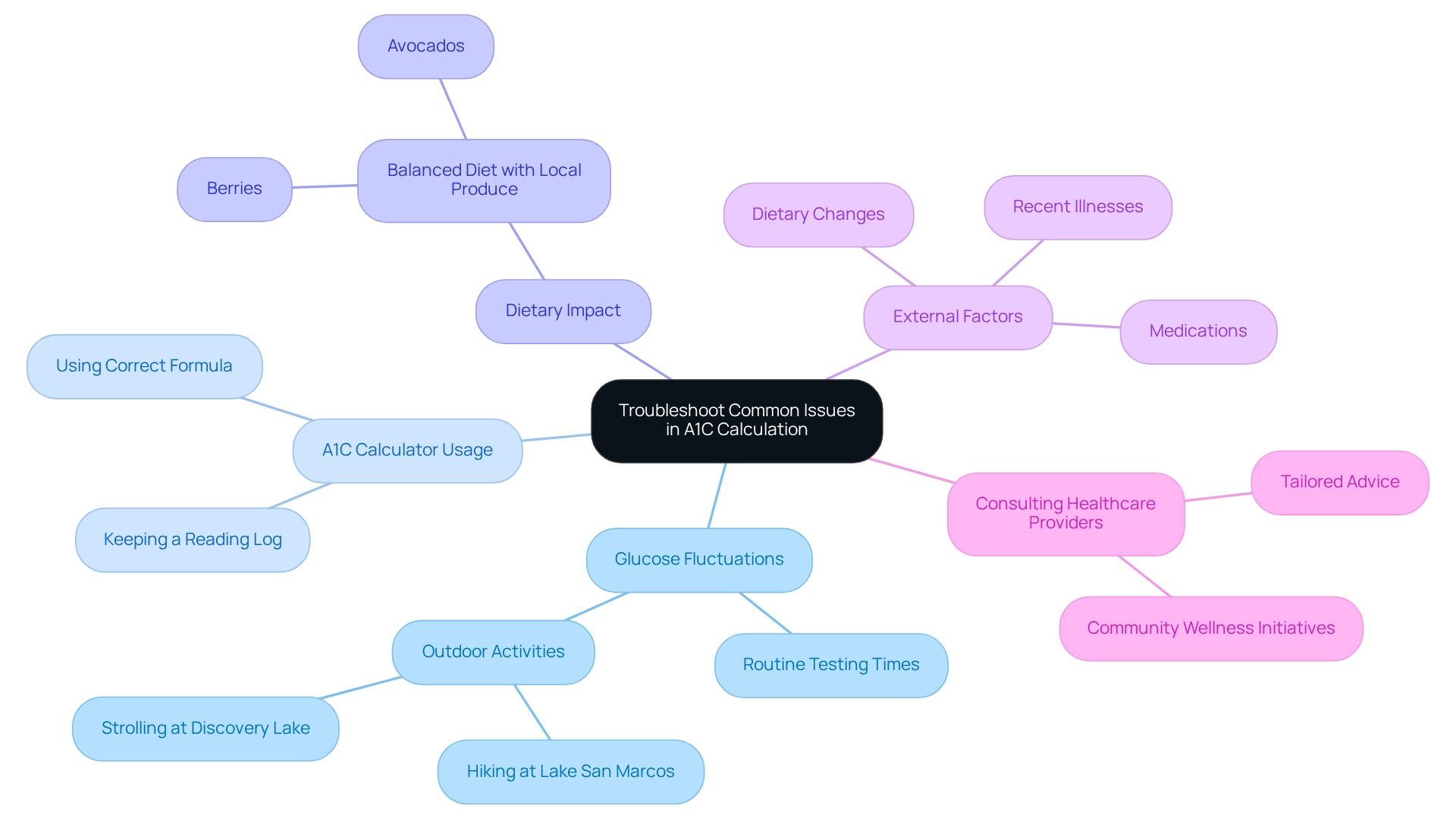Overview
Managing diabetes can feel overwhelming at times, but mastering the A1C chart calculator can be a significant step toward regaining control over your health. This tool plays a crucial role in tracking and controlling blood sugar levels, which is essential for effective diabetes management. It’s important to recognize that understanding your A1C levels, along with utilizing tools like glucose meters and A1C calculators, can empower you to set meaningful health goals.
Many patients find that by monitoring their progress, they can reduce the risk of complications associated with diabetes. Imagine feeling more confident in your ability to manage your condition! By taking small, consistent steps, you can make a real difference in your health journey.
As you explore these tools, remember that you’re not alone. Many individuals share similar struggles, and together, we can support each other in achieving better health. Embracing this knowledge and taking action can lead to a healthier, more fulfilling life.
Introduction
In the realm of diabetes management, it’s important to recognize that understanding and monitoring A1C levels is crucial for achieving optimal health outcomes. The A1C test serves as a vital indicator of average blood sugar levels over the past two to three months. This helps both patients and healthcare providers gauge the effectiveness of treatment plans. With classifications ranging from normal to prediabetes and diabetes, mastering this test not only empowers individuals to take control of their health but also highlights the importance of lifestyle changes, such as diet and exercise, in managing diabetes.
Many patients find that as diabetes prevalence continues to rise, the need for effective monitoring and intervention becomes increasingly critical. This underscores the significance of A1C in the broader context of health and well-being. By focusing on these key aspects, we can foster a supportive environment that encourages individuals to embrace healthier living and take proactive steps in their diabetes journey.
Understand A1C: Importance and Measurement
The A1C test, or hemoglobin A1C, is a vital diagnostic tool that measures the percentage of glucose attached to hemoglobin in red cells. This test indicates average blood sugar levels over the prior two to three months, making it crucial for effective management of your condition. An A1C level below 5.7% is categorized as normal, while levels between 5.7% and 6.4% suggest prediabetes, and 6.5% or above verifies the condition. Understanding these thresholds empowers you to set achievable goals and monitor your progress using an A1C chart calculator. Recent studies underscore the importance of maintaining optimal A1C levels, as they are directly linked to treatment outcomes. Many patients find that individuals with well-managed A1C levels experience fewer complications related to blood sugar conditions, such as cardiovascular issues. Participating in consistent physical activity—at least four hours weekly—can greatly lower the likelihood of heart disease, a vital concern for those managing type 2 diabetes.
In San Marcos, CA, adopting an active lifestyle through outdoor pursuits such as hiking at Lake San Marcos or walking the paths at Discovery Lake can improve insulin sensitivity and assist in regulating sugar levels. Alongside a balanced diet abundant in local produce from lively farmers’ markets, including avocados and berries, these lifestyle adjustments can significantly influence A1C control and your overall health. It’s important to recognize that current statistics show a notable percentage of individuals with type 2 conditions find it challenging to keep their A1C levels within the advised range. This underscores the necessity for continual monitoring and the use of an A1C chart calculator. Regular A1C testing, which can be tracked using an A1C chart calculator, not only helps in monitoring sugar control but also acts as an early warning system for potential complications, such as kidney damage. This can be evaluated through tests like the Albumin-to-Creatinine Ratio (ACR), which quantifies the level of albumin in urine, assisting in identifying early indicators of kidney harm, enabling prompt intervention and oversight.
Additionally, the financial consequences of diabetes care are substantial. On average, medical costs for individuals with diagnosed diabetes are 2.6 times greater than for those without diabetes. This highlights the significance of effective A1C oversight not only for health outcomes but also for decreasing healthcare expenses. To assess A1C levels, a straightforward blood test is performed, which can be analyzed with an A1C chart calculator, usually during regular check-ups. This test offers valuable insights into long-term glucose control, enabling healthcare providers to customize treatment plans effectively.
As the prevalence of this condition continues to grow, with forecasts suggesting that over 1.3 billion individuals may be impacted by 2050, comprehending and using the A1C test becomes increasingly crucial for those managing their health. Moreover, sustaining a healthy weight and diet, together with consistent physical activity, can avert or postpone the onset of prediabetes and Type 2 conditions. This further highlights the comprehensive strategy required in controlling these health issues. For personalized guidance and support tailored to your unique needs, consider reaching out to Dr. Jason Shumard in San Marcos, CA, who is dedicated to helping you navigate your diabetes management journey with care and expertise.
Gather Necessary Tools for A1C Calculation
To accurately calculate your A1C, it’s essential to have the right tools at your disposal.
- Glucose Meter: This device is crucial for measuring your sugar levels throughout the day. By tracking these readings, you can gain a comprehensive understanding of your glucose patterns, which is so important for your health journey.
- Consider using an A1C chart calculator, like the ones available online or through mobile applications. These resources can help you transform your average glucose readings into A1C percentages. Notable tools include the American Diabetes Association’s A1C chart calculator and various health-focused apps that are designed to be user-friendly.
- Logbook or App: Keeping a record of your daily blood glucose readings is vital for accurately calculating your average. This log will not only assist in your A1C calculations but also help you monitor your progress over time, providing valuable insights into your strategies.
- Fitness Applications and Logs: Integrating fitness applications and logs into your health routine can significantly enhance your ability to observe and manage your condition effectively. These tools can help keep you engaged and accountable on your health journey.
Integrating these tools into your health management routine can greatly improve your capacity to monitor and manage your condition. It’s important to recognize that statistics show only 21% of individuals share their self-monitoring glucose (SMBG) results daily. This highlights a gap in management practices and the need for improved engagement with these essential tools. As Dr. Jason Shumard states, “By providing patients with actionable insights and practical tools, the center fosters an environment where individuals can reclaim their health and well-being.”
Furthermore, implementing SMART goals—specific, measurable, attainable, relevant, and time-bound—can boost your focus and motivation in managing your diabetes. For instance, you might set a goal to keep your glucose levels within a specified range for a month. By leveraging technology and consistent tracking, you empower yourself to achieve better health outcomes.
Follow Step-by-Step Instructions for A1C Calculation
To accurately calculate your A1C using an A1C chart calculator, follow these detailed steps:
-
Collect Your Glucose Readings: Gather at least 10 glucose measurements from your meter over the past two to three months for a reliable average. It’s essential to calculate your average glucose level by summing all your readings and dividing by the number of readings to determine your average glucose level.
-
Use the A1C Conversion Formula: Convert your average blood glucose (in mg/dL) to A1C using the formula:
A1C (%) = (Average Blood Glucose + 46.7) / 28.7
For instance, if your average blood glucose is 150 mg/dL:
A1C = (150 + 46.7) / 28.7 = 6.9%
-
Interpret Your Results: Compare your A1C percentage against normal ranges to assess your condition oversight. If your A1C surpasses your goal, it’s important to consult your healthcare provider to modify your treatment plan accordingly.
Recent studies indicate that maintaining an average glucose level below 154 mg/dL, with a standard deviation under 50 mg/dL, is essential for effective control of blood sugar levels. It’s important to recognize that factors like age, gender, ethnicity, and smoking background can affect the connection between A1C and average glucose levels, emphasizing the intricacies involved in managing your condition. Understanding these metrics can significantly enhance your ability to manage your health.
Additionally, patient education plays a vital role in this process. As illustrated in the case study titled ‘Empowerment through Education,’ informed patients feel more empowered and capable of managing their health effectively. Dr. Howard Zisser emphasizes the importance of this approach, stating, ‘A big thanks to the following dozen brilliant advisors, who provided fantastic feedback on this article.’ This underscores the value of collaboration and education in achieving better health outcomes.
To further assist with your condition, consider establishing SMART goals—specific, measurable, attainable, relevant, and time-bound—related to your sugar levels and overall health. For instance, aim to lower your average glucose level by a specific percentage over the next month. Regularly reviewing your progress not only fosters accountability but also allows for the adaptation of goals in response to changing fitness levels.
After using the A1C chart calculator to calculate your A1C, think about discussing your results with your healthcare provider to explore further steps in your management plan. Incorporate lifestyle strategies such as engaging in regular physical activity, like walking or hiking in the scenic parks of San Marcos, to enhance your overall health. Concentrate on a balanced diet abundant in local produce, like avocados and berries, which can assist in regulating sugar levels.
Furthermore, think about engaging with community wellness initiatives in San Marcos that provide assistance and resources designed for effectively managing blood sugar. These local resources can provide invaluable assistance and motivation as you work towards your health goals.
Troubleshoot Common Issues in A1C Calculation
Calculating your A1C can present several challenges that may affect the accuracy of your results.
It’s important to recognize that many diabetes patients experience fluctuations in their glucose levels, leading to unreliable A1C results. To ensure consistency, try taking readings at the same times each day, ideally before meals and at bedtime. Many patients find that routine outdoor activities, such as hiking at Lake San Marcos or strolling the paths at Discovery Lake, can assist in stabilizing sugar levels and enhancing insulin sensitivity.
Another common concern is the incorrect use of the A1C chart calculator. It’s crucial to use the correct formula when making calculations. Verify that you are inputting your average glucose levels accurately, as even minor errors can skew your results. Keeping a log of your readings can facilitate this process. Additionally, a balanced diet abundant in local produce, like avocados and berries from San Marcos farmers’ markets, promotes improved sugar regulation.
If your A1C appears unusually high or low, consider external factors such as recent illnesses, medications, or dietary changes that could impact your blood sugar levels. For instance, a study highlighted that 8.0% of adults with diagnosed sugar-related conditions had non-HDL levels of 190 mg/dL or higher, indicating the importance of comprehensive health monitoring. Furthermore, the escalating surplus healthcare expenses related to this condition, which rose from $10,179 to $12,022 between 2012 and 2022, highlight the financial consequences of inadequate care. Understanding the dangers of elevated insulin levels is crucial, as they can lead to various health issues, including heart disease and insulin resistance.
If you consistently encounter difficulties with your A1C calculations or if your results raise concerns, it’s essential to consult your healthcare provider. They can provide tailored advice and assistance, helping you handle any challenges in your health care. Participating in community wellness initiatives in San Marcos can offer extra resources and assistance customized to your requirements.
By tackling these typical concerns and incorporating comprehensive lifestyle approaches, you can improve the precision of your A1C assessments with the A1C chart calculator and more effectively oversee your condition. Engaging with educators specializing in blood sugar issues can offer valuable insights into resolving A1C calculation mistakes, ensuring you possess the tools essential for effective health supervision. Moreover, a multifactorial approach to reducing cardiovascular risk highlights the necessity for comprehensive strategies in managing blood sugar levels that balance glycemic control with overall health management. For personalized support, consider reaching out to Dr. Jason Shumard at the Integrative Wellness Center, where tailored nutrition plans and diabetes education programs are available to assist you on your journey.
Conclusion
Understanding and monitoring A1C levels is essential for effectively managing diabetes. The A1C test not only provides a glimpse into your average blood sugar levels over the past two to three months but also empowers you to set achievable health goals. It’s important to recognize that mastering this test is crucial for fostering proactive health management and minimizing the risk of complications.
Regular monitoring and lifestyle adaptations, such as increasing physical activity and maintaining a balanced diet, play pivotal roles in keeping your A1C levels in check. Many patients find that engaging in local activities, like hiking or accessing fresh produce from farmers’ markets, can enhance overall health and support glucose control. Furthermore, utilizing tools like blood glucose meters and A1C calculators can help you track your progress effectively, ensuring a comprehensive approach to managing diabetes.
The financial implications of diabetes management further highlight the importance of effective A1C control. By prioritizing A1C management and implementing holistic lifestyle changes, you can improve your health outcomes and mitigate healthcare costs associated with diabetes complications. As the prevalence of diabetes continues to rise, embracing the A1C test and the accompanying lifestyle modifications becomes increasingly vital in navigating your diabetes journey. Ultimately, staying informed and engaged with healthcare providers and community resources is essential for achieving long-term health and well-being.
Frequently Asked Questions
What is the A1C test?
The A1C test, or hemoglobin A1C, measures the percentage of glucose attached to hemoglobin in red blood cells, indicating average blood sugar levels over the prior two to three months.
What do the A1C levels indicate?
An A1C level below 5.7% is normal, 5.7% to 6.4% indicates prediabetes, and 6.5% or above verifies diabetes.
Why is maintaining optimal A1C levels important?
Maintaining optimal A1C levels is crucial as it is directly linked to treatment outcomes, with well-managed levels associated with fewer complications, such as cardiovascular issues.
How can physical activity affect A1C levels?
Engaging in consistent physical activity, such as at least four hours weekly, can significantly lower the likelihood of heart disease and improve insulin sensitivity, aiding in the regulation of sugar levels.
What lifestyle changes can help manage A1C levels?
Adopting an active lifestyle through outdoor activities, along with a balanced diet rich in local produce, can significantly influence A1C control and overall health.
What is the significance of regular A1C testing?
Regular A1C testing helps monitor blood sugar control and acts as an early warning system for potential complications, such as kidney damage.
How are A1C levels assessed?
A1C levels are assessed through a simple blood test, which can be analyzed with an A1C chart calculator during regular check-ups.
What are the financial implications of diabetes care?
Individuals with diagnosed diabetes incur medical costs that are, on average, 2.6 times greater than those without diabetes, highlighting the importance of effective A1C management for both health and financial reasons.
What is the projected prevalence of diabetes by 2050?
It is forecasted that over 1.3 billion individuals may be impacted by diabetes by 2050, making the understanding and use of the A1C test increasingly crucial for health management.
How can individuals get personalized support for diabetes management?
Individuals seeking personalized guidance can reach out to healthcare professionals, such as Dr. Jason Shumard in San Marcos, CA, who specializes in diabetes management.



